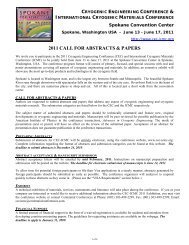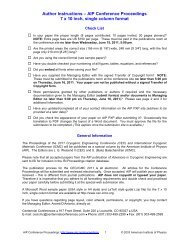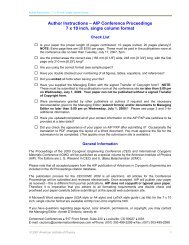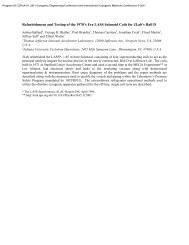CEC Abstracts in PDF format (as of 7/3/07) - CEC-ICMC 2013
CEC Abstracts in PDF format (as of 7/3/07) - CEC-ICMC 2013
CEC Abstracts in PDF format (as of 7/3/07) - CEC-ICMC 2013
Create successful ePaper yourself
Turn your PDF publications into a flip-book with our unique Google optimized e-Paper software.
<strong>CEC</strong> 20<strong>07</strong> - <strong>Abstracts</strong><br />
C2-K-03 Evolution <strong>of</strong> the standard helium liquefier and<br />
refrigerator range designed by Air Liquide Advanced<br />
Technology Division, France<br />
A. Caillaud, S. Crispel, V. Grabié, F. Delcayre, G.<br />
Aigouy, Air Liquide DTA.<br />
The standard helium liquefier and refrigerator range, called HELIAL<br />
and designed by Air Liquide DTA, h<strong>as</strong> recently been upgraded <strong>in</strong><br />
order to improve the efficiency <strong>of</strong> these mach<strong>in</strong>es. Indeed <strong>in</strong> the multirange<br />
<strong>of</strong> markets requir<strong>in</strong>g these cryogenic systems, (<strong>in</strong>ternational<br />
laboratories, aerospace applications, synchrotrons, HTS<br />
applications...), the technological solution h<strong>as</strong> to provide <strong>in</strong>cre<strong>as</strong><strong>in</strong>gly<br />
high performances. The new HELIAL Evolution range, equipped with<br />
very reliable DTA turbo-expanders, will constitute a highly efficient<br />
product for this wide application field. The optimizations, adaptations<br />
and results <strong>of</strong> the HELIAL Evolution series, doubl<strong>in</strong>g the performance<br />
for the same electrical consumption, will be presented.<br />
C2-K-04 Cryocooler for Air Liquefaction Onboard Large<br />
Aircraft<br />
J.J. Breedlove, P.J. Magari, Creare Inc.; G.W. Miller,<br />
Air Force Research Laboratory.<br />
Creare h<strong>as</strong> developed a turbo-Brayton cryocooler designed to produce<br />
approximately 1 kW <strong>of</strong> refrigeration at 95 K. The cryocooler is<br />
<strong>in</strong>tended to provide cryogenic cool<strong>in</strong>g to an air separation system<br />
be<strong>in</strong>g developed for the Air Force to produce and store liquid oxygen<br />
and liquid nitrogen onboard large aircraft. The oxygen will be used<br />
for high-altitude breath<strong>in</strong>g and medical evacuation operations, while<br />
the nitrogen will be used to <strong>in</strong>ert the ullage space <strong>in</strong>side the fuel tanks.<br />
The cryocooler utilizes g<strong>as</strong> bear<strong>in</strong>gs <strong>in</strong> the turbomach<strong>in</strong>es for long life<br />
without ma<strong>in</strong>tenance, which is a critical requirement for this<br />
application. The m<strong>as</strong>s <strong>of</strong> a flight version <strong>of</strong> this cryocooler is<br />
expected to be around 270 kg, while the <strong>in</strong>put power is expected to be<br />
approximately 25 kW. This paper describes the design and test<strong>in</strong>g <strong>of</strong><br />
the laboratory demonstration cryocooler that w<strong>as</strong> constructed to<br />
demonstrate the fe<strong>as</strong>ibility <strong>of</strong> the approach. In the future, the<br />
cryocooler will be <strong>in</strong>tegrated and tested with a distillation column<br />
subsystem. Subsequent test<strong>in</strong>g may also be performed <strong>in</strong>-flight on an<br />
Air Force transport aircraft.<br />
C2-K-05 Process Study <strong>of</strong> Nom<strong>in</strong>al 2 K Refrigeration<br />
Recovery<br />
P.N. Knudsen, V. Ganni, Jefferson Lab.<br />
There is an <strong>in</strong>cre<strong>as</strong>ed <strong>in</strong>terest <strong>in</strong> the nom<strong>in</strong>al 2K helium refrigeration<br />
systems (below lambda) for test stands at the present time. This paper<br />
presents the process parameter choices and their <strong>in</strong>fluence on the<br />
system performance <strong>of</strong> various non-cold compressor configurations.<br />
This study is <strong>in</strong>tended to facilitate the adoption <strong>of</strong> this process <strong>in</strong><br />
conjunction with commercially available small 4.5K helium<br />
refrigerator systems. By way <strong>of</strong> an <strong>in</strong>troduction, the efficiency <strong>of</strong><br />
some commonly employed (but <strong>in</strong>efficient) 2 K process<br />
configurations are analyzed. Then the analyses <strong>of</strong> three nom<strong>in</strong>al 2K<br />
refrigeration recovery process configurations utiliz<strong>in</strong>g a refrigeration<br />
recovery heat exchanger are presented. The effect <strong>of</strong> the process<br />
parameters, such <strong>as</strong> flow imbalance, heat exchanger size, supply<br />
pressure and 4.5K plant <strong>in</strong>jection location are <strong>in</strong>vestigated so that the<br />
conditions yield<strong>in</strong>g the maximum coefficient <strong>of</strong> performance can be<br />
determ<strong>in</strong>ed.<br />
C2-K-06 Recent progress <strong>in</strong> dynamic process simulations<br />
<strong>of</strong> cryogenic refrigerators<br />
A. Kuendig, L<strong>in</strong>de Kryotechnik AG.<br />
At the <strong>CEC</strong> 2005 a paper with the title “Helium refrigerator design for<br />
pulsed heat load <strong>in</strong> Tokamaks“ w<strong>as</strong> presented. That paper highlighted<br />
the control requirements for cryogenic refrigerators to cope with the<br />
expected load variations <strong>of</strong> future nuclear fusion reactors. First<br />
dynamic computer simulations have been presented.<br />
In the mean time, the computer program is enhanced and new series<br />
<strong>of</strong> process simulations are available. The new program considers not<br />
only the heat flows and the temperature variations with<strong>in</strong> the heat<br />
exchangers, but also the variation <strong>of</strong> m<strong>as</strong>s flow and pressure drops.<br />
The heat transfer numbers now are calculated <strong>in</strong> dependence <strong>of</strong> the<br />
flow speed and the g<strong>as</strong> properties. PI-controllers calculate the<br />
necessary position <strong>of</strong> specific valves for ma<strong>in</strong>ta<strong>in</strong><strong>in</strong>g pressures,<br />
temperatures and the rotation speed <strong>of</strong> turb<strong>in</strong>es.<br />
The value <strong>of</strong> such a program is the trac<strong>in</strong>g <strong>of</strong> difficult transient<br />
operat<strong>in</strong>g modes <strong>in</strong> the design ph<strong>as</strong>e <strong>of</strong> a refrigerator. The simulation<br />
further is helpful for test<strong>in</strong>g control programs <strong>in</strong> absence <strong>of</strong> the real<br />
refrigerator and it enables to f<strong>in</strong>d optimal control parameters. Worth<br />
mention<strong>in</strong>g that such a program is applicable for the education <strong>of</strong><br />
eng<strong>in</strong>eers and operators.<br />
C2-K-<strong>07</strong> Design <strong>of</strong> Subcooled Pressurized Cryogenic<br />
Systems<br />
G.E. McIntosh, Cryogenic Technical Services, Inc..<br />
High temperature superconduct<strong>in</strong>g power l<strong>in</strong>es and various beaml<strong>in</strong>e<br />
targets require cool<strong>in</strong>g with subcooled, non-boil<strong>in</strong>g cryogens <strong>in</strong> the<br />
pressure range from 5 to 15 Bar. In conventional closed-loop<br />
refrigerated systems this is accomplished by us<strong>in</strong>g a pressurized<br />
ball<strong>as</strong>t cryogen dewar to ma<strong>in</strong>ta<strong>in</strong> the desired pressure. Although<br />
consumption is modest, cryogen flows cont<strong>in</strong>uously from the ball<strong>as</strong>t<br />
dewar and periodic replenishment is necessary. This paper describes<br />
an <strong>in</strong>novative refrigerated system which elim<strong>in</strong>ates the ball<strong>as</strong>t dewar<br />
and operates cont<strong>in</strong>uously without cryogen or g<strong>as</strong>eous make-up after<br />
the <strong>in</strong>itial fill.<br />
C2-K-08 The Cost <strong>of</strong> Helium Refrigerators and Coolers<br />
for Superconduct<strong>in</strong>g Devices <strong>as</strong> a Function <strong>of</strong> Cool<strong>in</strong>g<br />
Power at 4.5 K<br />
M. A, Green, Lawrence Berkeley National<br />
Laboratory.<br />
This paper is written <strong>in</strong> memory <strong>of</strong> Rod Byrns <strong>of</strong> the Lawrence<br />
Berkeley National Laboratory who died two years ago.<br />
This paper is an update <strong>of</strong> papers written <strong>in</strong> 1991, 1997 by Rod Byrns<br />
and this author concern<strong>in</strong>g estimat<strong>in</strong>g the cost <strong>of</strong> refrigeration for<br />
superconduct<strong>in</strong>g magnets and cavities. The actual costs <strong>of</strong> helium<br />
refrigerators and coolers (escalated to 20<strong>07</strong> dollars) are plotted and<br />
compared to a correlation function. A correlation function between<br />
cost and refrigeration at 4.5 K and 1.8 K is given. The capital cost <strong>of</strong><br />
larger refrigerators (greater than 50 W at 4.5 K) 1s plotted <strong>as</strong> a<br />
function <strong>of</strong> 4.5 K cool<strong>in</strong>g. The cost <strong>of</strong> small coolers is also plotted <strong>as</strong><br />
a function <strong>of</strong> refrigeration available at 4.5 K. An annual cost for<br />
refrigeration can also be estimated b<strong>as</strong>ed on the refrigeration at 4.5 K<br />
or 1.8 K and the cost <strong>of</strong> electrical energy. A correlation function for<br />
estimat<strong>in</strong>g <strong>in</strong>put power to the compressors to the refrigeration<br />
produced at 4.5 K and 1.8 K is also given.<br />
This work w<strong>as</strong> supported by the Office <strong>of</strong> Science, United States<br />
Department <strong>of</strong> Energy, under DOE contract DE-AC02-<br />
05CH11231.<br />
C2-L Stirl<strong>in</strong>g and Pulse Tube Coolers,<br />
Development and Test<strong>in</strong>g (Aerospace)<br />
C2-L-01 Development Of A 4.5 K Pulse Tube Cryocooler<br />
For Superconduct<strong>in</strong>g Electronics<br />
Ted N<strong>as</strong>t , Jeff Olson , Patrick Champagne , Jack<br />
Mix, Bobby Evtimov, Eric Roth , Andre Collaco , ,<br />
Lockheed Mart<strong>in</strong> Space Co.<br />
Lockheed Mart<strong>in</strong>`s Advanced Technology Center is develop<strong>in</strong>g a four<br />
stage pulse tube to provide temperatures <strong>of</strong> 4.5 K for superconduct<strong>in</strong>g<br />
electronics to be used <strong>in</strong> a ground b<strong>as</strong>ed communications system. We<br />
have developed prior 4 stage units which have operated down to 3.8K.<br />
The relatively high cool<strong>in</strong>g loads for this program led us to a design<br />
which reduces the <strong>in</strong>put power over prior systems. The design <strong>of</strong> the<br />
system <strong>in</strong>cludes a unique pulse tube approach us<strong>in</strong>g both Helium-3<br />
and Helium 4 work<strong>in</strong>g g<strong>as</strong> <strong>in</strong> two separate compression spaces, which<br />
leads to enhanced power efficiency. The compressor is our standard<br />
mov<strong>in</strong>g magnet, clearance seal, flexure bear<strong>in</strong>g system. This paper<br />
will present the experimental data and compare it with our prediction<br />
methods.<br />
The system is compact, lightweight and reliable and utilizes our<br />
aerospace cooler technology to provide unlimited lifetime. The unit is<br />
an eng<strong>in</strong>eer<strong>in</strong>g model to demonstrate pro<strong>of</strong> <strong>of</strong> concept. Follow on<br />
production for ground b<strong>as</strong>ed communication systems is anticipated.<br />
This work is subcontracted from HYPRES and is funded by the Army<br />
and the Navy<br />
Page 28 <strong>of</strong> 53






